Reviewing 5E D&D Monsters - Mordenkainen's Tome of Foes, Pt 5 (Oblexes to Vampiric Mists)
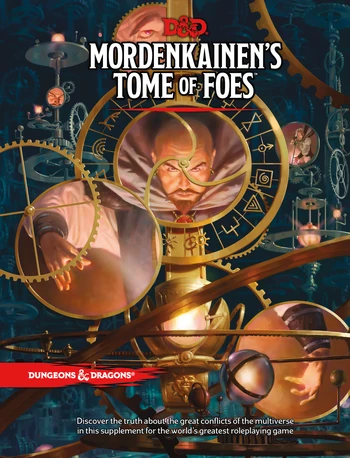
Additionally, I finally finished up actually reading the final parts of the first half of Mordenkainen's, with all its talk about elves and dwarves, which are pretty neat but too detail-oriented (I'd rather have that instead of a lack of detail, so no complaining there); Gith (which I still don't really care about... I don't think this changes a lot of the information I know about them from my 4E days) and Halflings (which I'm surprised they got a fair amount of mileage out of). For the most part, a lot of the lore segments either details the fiends and the hierarchy of the Abyss and the Nine Hells, or just describe the general culture of elves, dwarves, gith and halflings. A wee bit too much focus on detailing the gods and origin of the elves, but, again, I'd rather have more details than not enough.
Most of the contents of Mordenkainen's, other than the detailed specifics of the five big races they talk about, really is mostly just minutiae spelling out the proper details of these races that the Player's Handbook and DM Guide doesn't go into... and the fact that I have already known a significant chunk of this from 4E and 3.5E might be why this wasn't quite as interesting of a read as Volo's. We also do spend a fair amount of time talking about new sub-race variants as playable characters, although most of them are also detailed in the monsters segment, and the ones that we haven't covered, like the Sea Elves, don't really get any real meaningful lore for me to talk about, or are just not too different lore-wise like the Tiefling variants.
What next? I don't think I care all that much about reviewing race variants or class variants, since it'll be monotonous, so I'll be skipping over the next 'core' sourcebook, Xanathar's Guide to Everything, which is more of an expansion pack to the DM and Player's Handbooks. I'll do the shorter Mordenkainen's Fiend Folio next, and then I am sort of deliberating on whether I'll talk about the adventure modules (in order, I guess?) or do one-offs like the 4E Monster Manual or the 1E Fiend Folio or something.
Anyway, here goes the rest of the book after we leave the fiends behind!
- Click here for the previous part of Mordenkainen's, covering Devils and Yugoloths.
- Click here for the next 5E book, Mordenkainen's Fiend Folio.
- Click here for the index.
________________________________

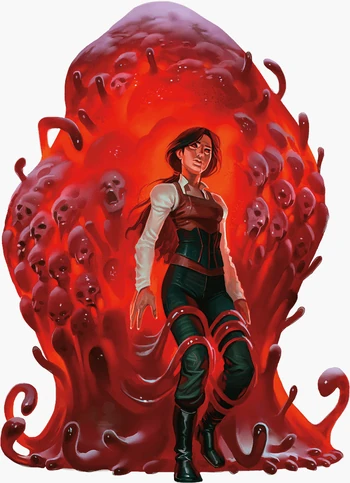
Oblex- 5.5E/5E: Tiny Ooze; Lawful Evil; CR 1/4 (Spawn)
- 5.5E/5E: Medium Ooze; Lawful Evil; CR 5 (Adult)
- 5.5E/5E: Huge Ooze; Lawful Evil; CR 10 (Elder)
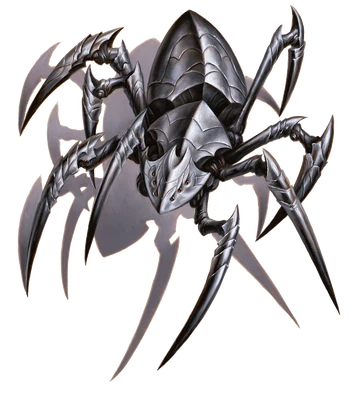
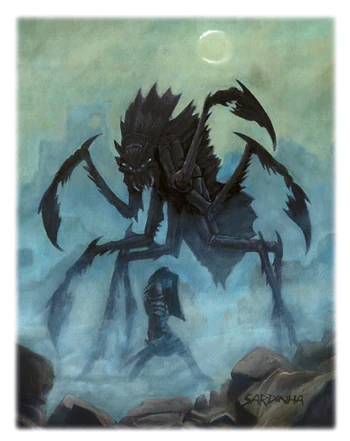
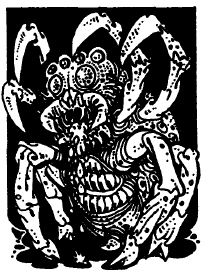
Retriever - 5.5E/5E: Large Construct; Lawful Evil; CR 14
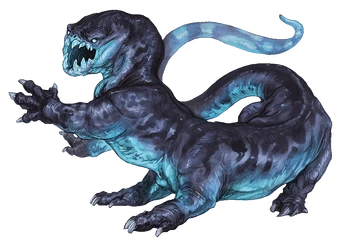
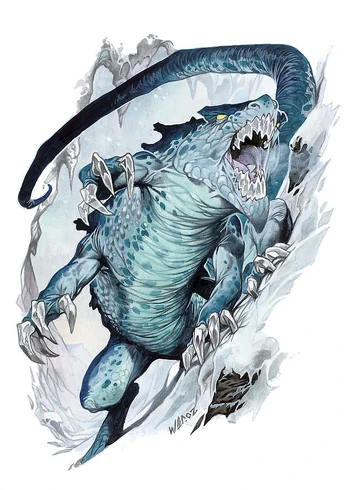
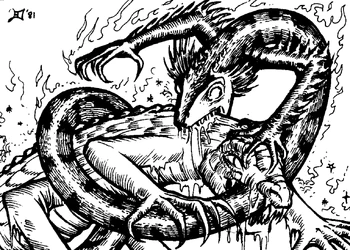
Frost Salamander - 5.5E/5E: Huge Elemental; Unaligned; CR 9
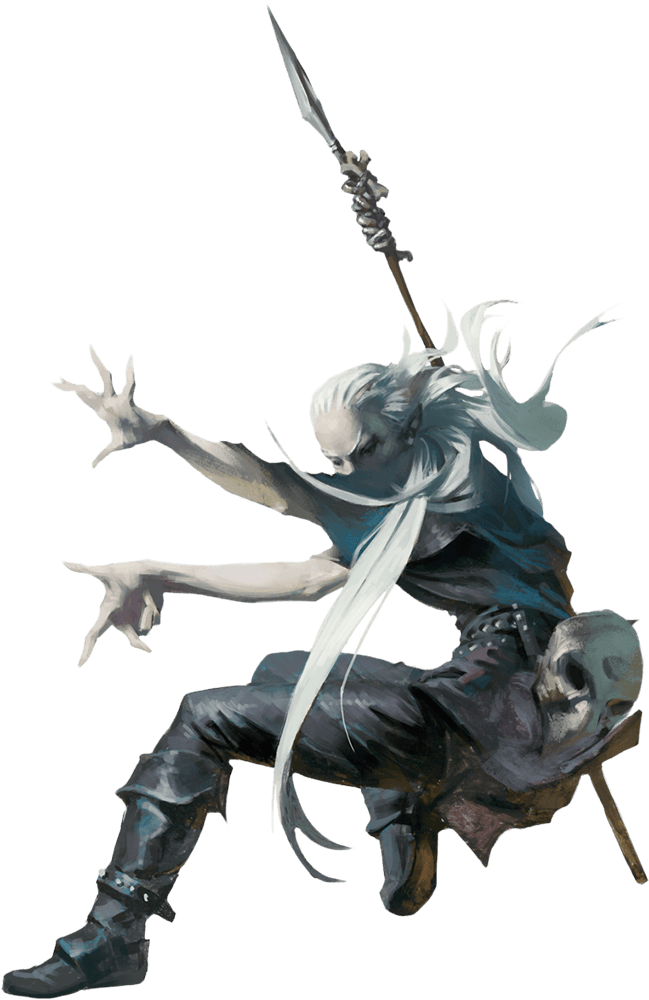
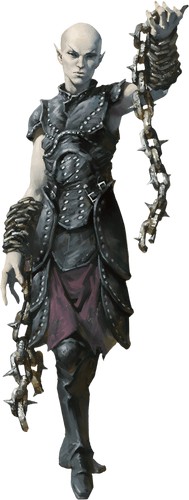
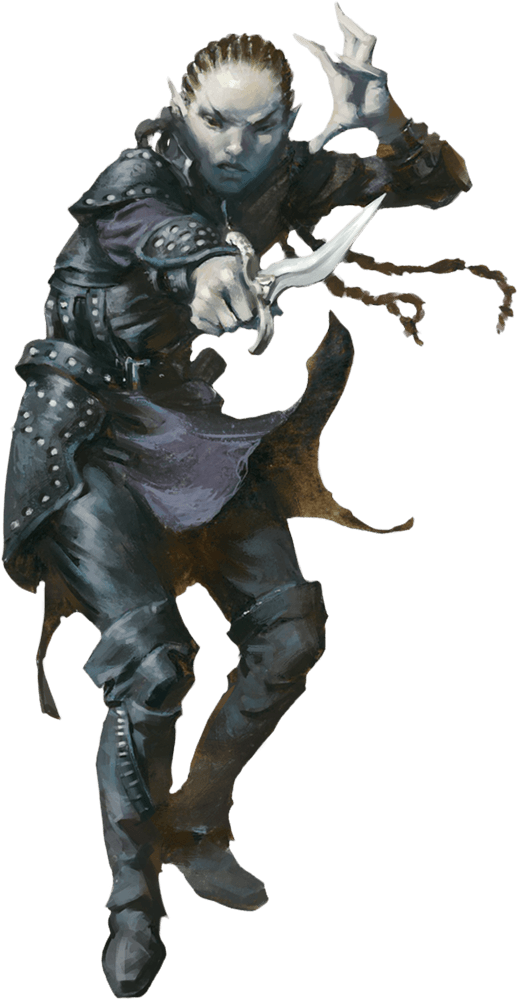
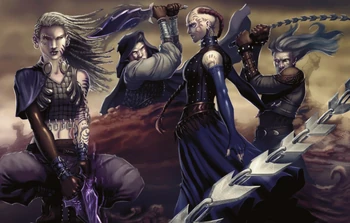
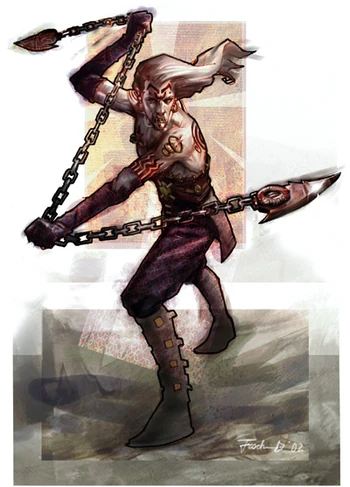
Shadar-Kai - 5.5E/5E: Medium Humanoid; Neutral; CR 9 (Gloom Weaver), 7 (Shadow Dancer), 11 (Soul Monger)
The Shadar-Kai scout out choice souls and tragedies that might please their patron, the Raven Queen, and will sometimes coax worldly events along tragic paths to please their goddess. Unfortunately for the Shadar-Kai, the Raven Queen is a very cryptic and enigmatic goddess, so all they get out of it is vague, easily-misinterpreted maybe-compliments. It honestly mostly just gives DM's an excuse to use them as completely antagonistic, completely allied to the party, or just vaguely enigmatic for enigma's reason, which is certainly not a complained. Physically they are described as 'withered elves', with pale hair, wrinkled gray skin and swollen joints, although apparently they will somehow look a bit more youthful (if still deathly pale) if they enter another realm, only reverting to their true wrinkly self when they return to the Shadowfell.
As with its other humanoid races, Tome of Foes immediately gives us three variants for the Shadar-Kai. From left to right on that 5E artwork are the Gloom Weaver, the Shadow Dancer and the Soul Monger, and they are so delightfully emo-sounding names. The Gloom Weaver's whole deal is that while it's a powerful sorcerer, it prefers to sneak in the shadows and uses the dark energies from his very presence to weigh down the enemy's heart (and this is not exaggeration, by the way), in an attempt to please the Raven Queen. Shadow Dancers... move from shadows to shadows, which is something we've seen many times in D&D but is never not cool. Soul Mongers, meanwhile, use their 'aching void within their souls' to radiate outward and make other people extra sad and lose their vigour. They are so freaking emo!
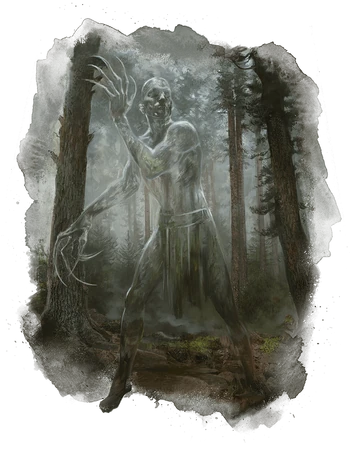
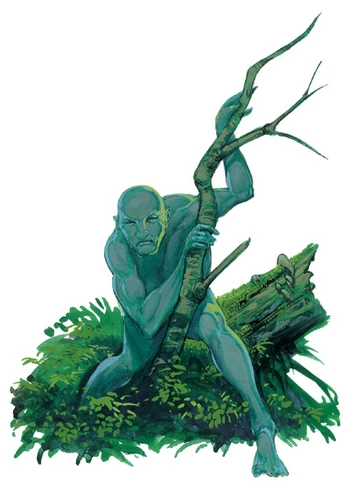
Skulk - 5.5E/5E: Medium Humanoid; Chaotic Neutral; CR 1/2
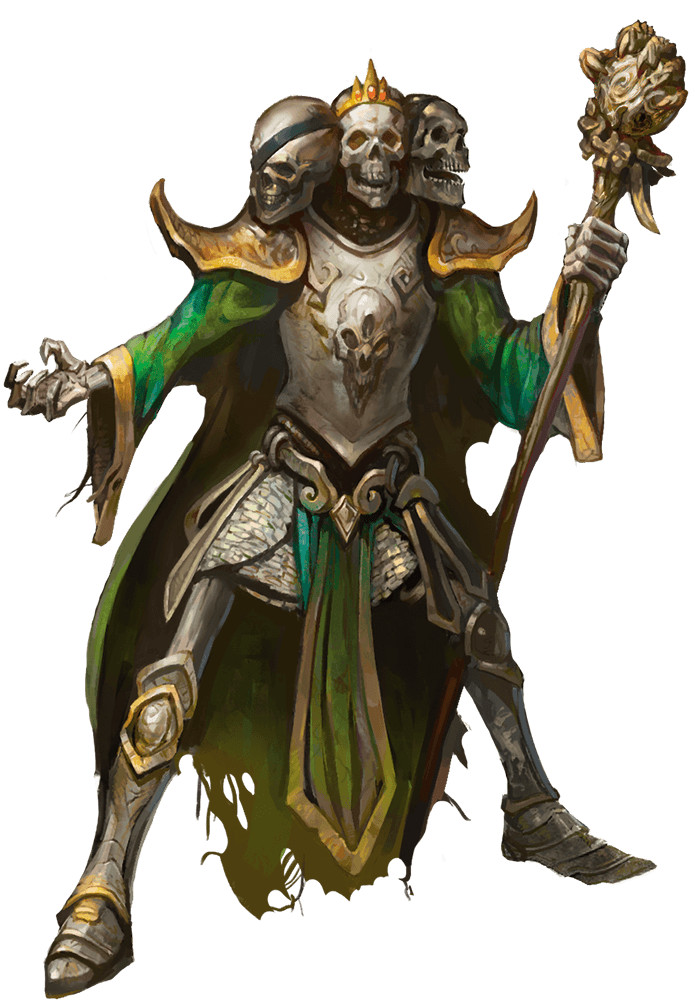
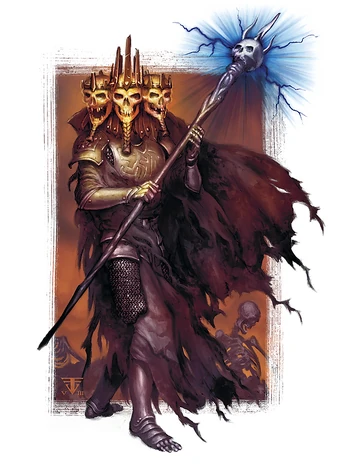
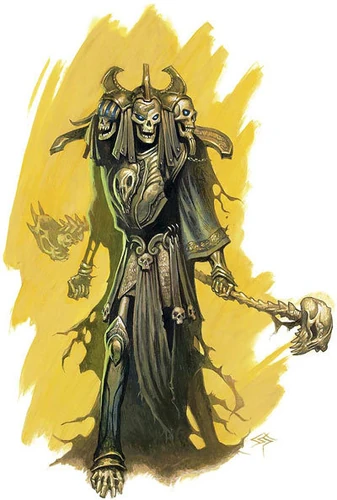
Skull Lord - 5.5E/5E: Medium Undead; Lawful Evil; CR 15
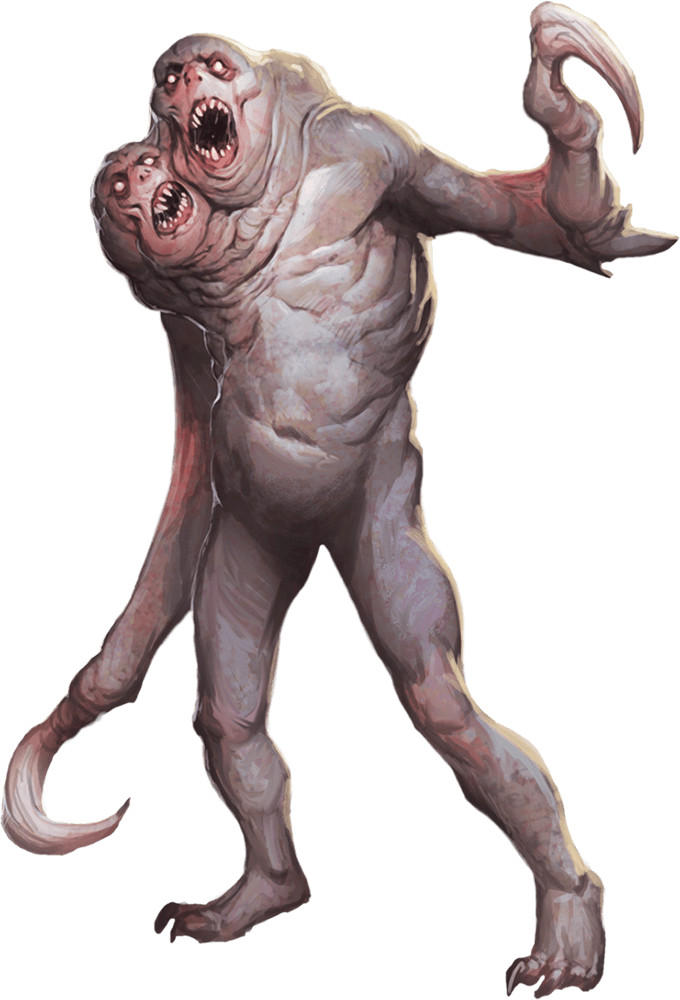
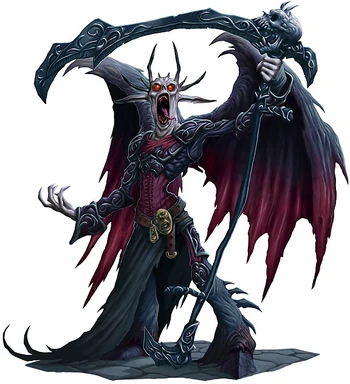
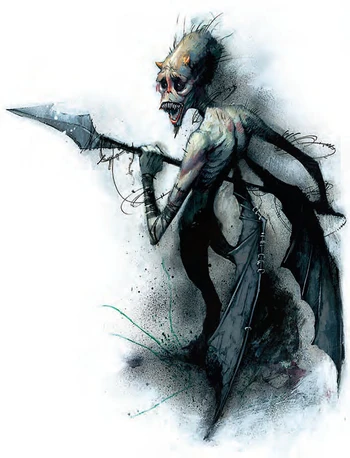
Sorrowsworn - 5.5E/5E: Medium Monstrosity; Neutral Evil; CR 13 (Angry), 11 (Hungry), 9 (Lonely), 7 (Lost)
- 5.5E/5E: Small Monstrosity; Neutral Evil; CR 1/4 (Wretched)
And oh boy here we go. The Sorrowsworn in 3E and 4E are just another type of demon, and while the 3E artwork is sure cool as a wretched, sorrowful little demon-man; and 4E's... got a huge mouth I guess; it is the 5th Edition's reinvention of the Sorrowsworn and moving them away from being just yet-another-demon into something that's truly memorable. They are now yet another denizen of the Shadowfell, a plane that Tome of Foes is clearly expanding upon with the Skulks, the Shadar-Kai, the Nightshades, the Skull Lords and the Meazels, but the Sorrowsworn are easily the creepiest among the creatures there. Looking like they stepped out of some Silent Hill game or whatever, the Sorrowsworn are born out of the 'pervasive melancholy' of the Shadowfell, embodying the forms of suffering that are inherent to the shadowy landscape, and although they look like hideous, mutated humans, they're actually negative emotions given form, which fits with the whole emo-goth vibe of the Shadowfell perfectly (which I love, by the way) and in addition to being pretty creepy and stuff, the Sorrowsworn are immensely strengthened if you display the negative emotions they represent, and become weaker if you fight against these emotions. Of course, when you're being waylaid by crazy emancipated men with five swords for arms, you probably have higher priorities than keeping your emotions under control, yeah? Tome of Foes gives us five variants -- The Angry, The Hungry, The Lonely, The Lost and The Wretched, all of which are very awesome names.
The Angry, just looks so painful. Perhaps not quite as wrathful as I would've preferred, though the misshapen torso and the gangly arms ending in sickles are pretty creepy. None quite as creepy as the two heads that are conjoined in a very painful-looking manner, and, of course The Angry's two heads will bicker with each other until they find a distraction upon which they can vent their anger. Interestingly, The Angry grows even more powerful when their foes fight back... and their attacks weaken if a creature opts not to attack, since they get confused... but you're still being attacked by a two-headed malformed creature with sickles for arms, so, uh, yeah.
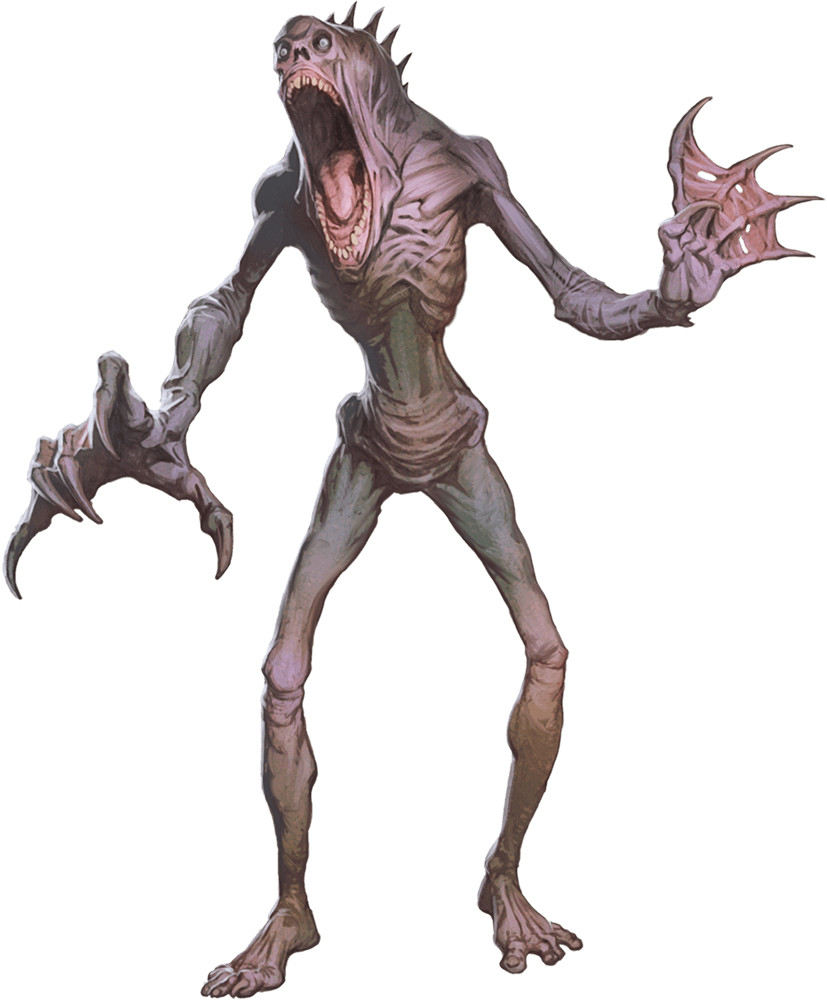

The Hungry is also a ghoulish, emancipated humanoid that looks extra-malnourished compared to its other buddies, and, of course, it's a hungry creature with a massive, stretched-open mouth that looks like something straight out of a horror game. A fan of those long, webbed claws, too. These are probably the most simple among the Sorrowsworn, they're just hungry and they want to consume and they will eat whatever they cross path with.
The Lonely, meanwhile, has such a sad, creepy face, like a sad creepy doll with tear stains. Their arms are giant harpoons that they can launch, because they are so, so lonely that they just want a friend, and they will use their harpoon arms to stab anyone they cross path with to drag their victims close. I wonder what this creature will do, though, if someone actually decides to hang out with it? Does it just disappear?
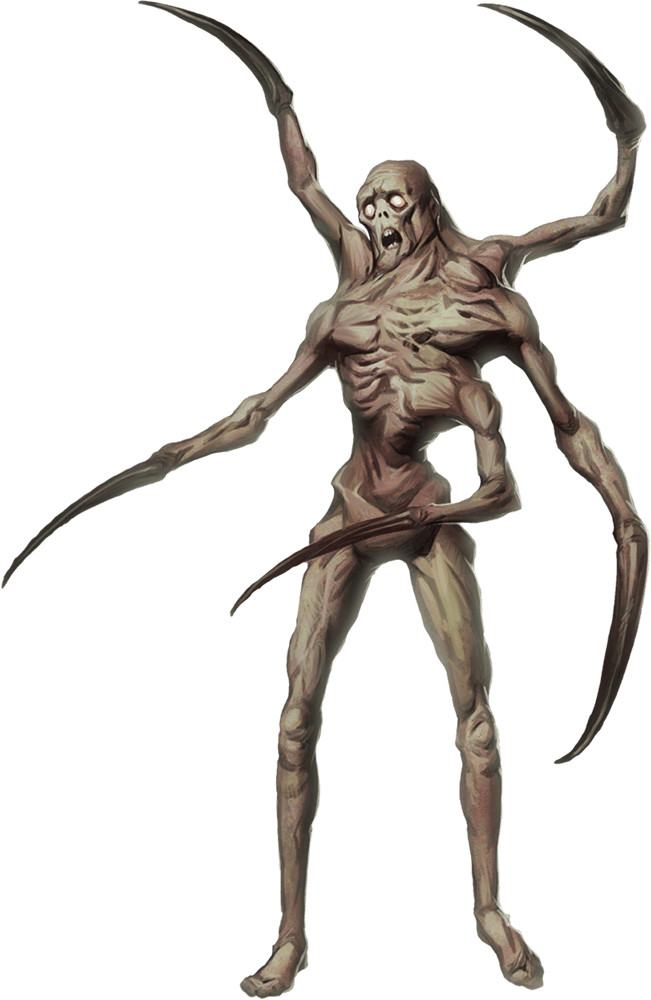
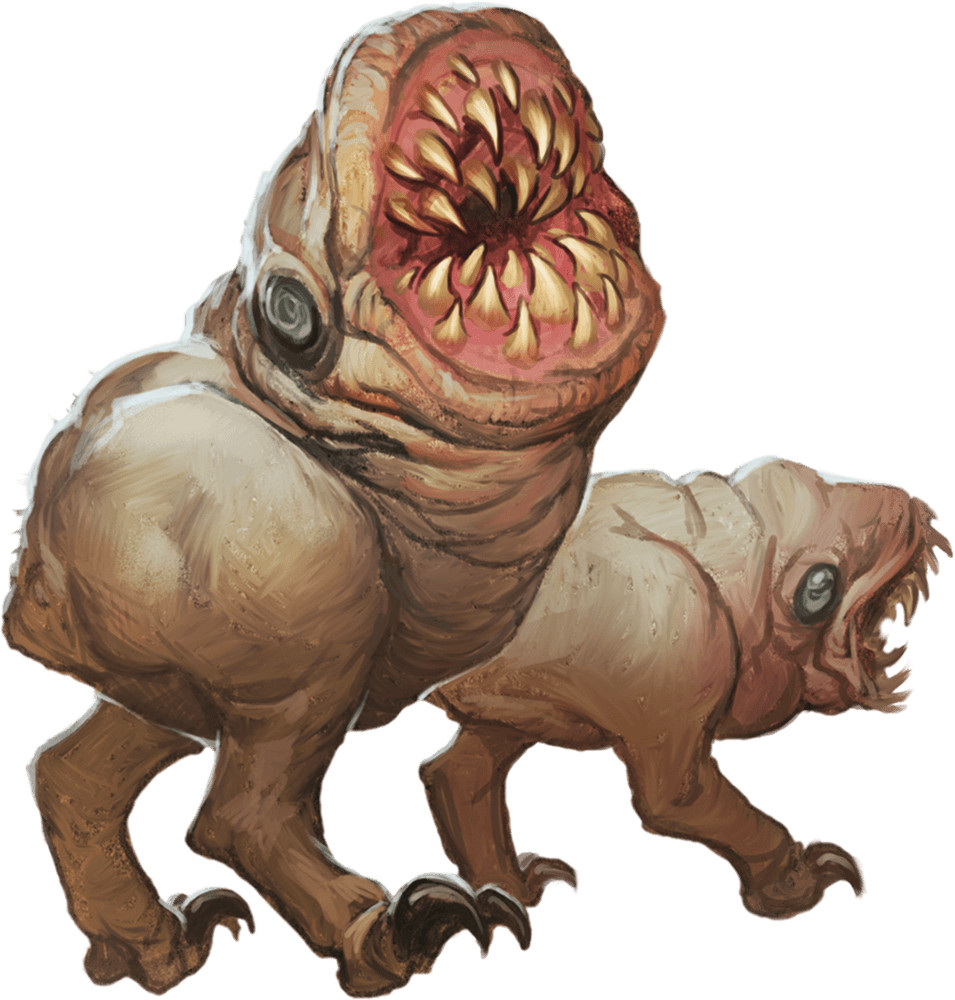
The Lost are the representations of anxiety and fear that people experience when they get lost in the Shadowfell (which is very easy to happen) and are desperate, panicked, and "try to embrace any creature they reach" in an attempt to find comfort. They literally just wants a hug, but unfortunately they are hideous five-armed creatures whose arms end in massive swords, so their hugs are fatal, and contact with them wracks the mind of the people they hug with a flood of fear and panic. Poor Lost, they just want a hug.
The Wretched are the obligatory 'little, weak, swarming' variant, and they are just these pudgy lumps of chicken-like flesh whose faces are a massive Sarlacc maw. They still look gross and creepy thanks to their fleshy colouration and those dead-eyes, but compared to its four other Sorrowsworn buddies, they look almost cute? They don't quite embody an emotion like the other four, and they're just basically pack hunters looking for life energy and fear.

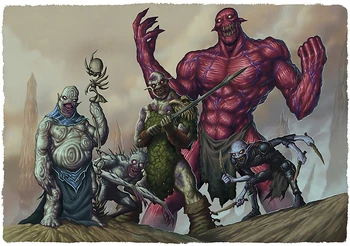
Star Spawn / Farspawn- 5.5E/5E: Small Aberration; Neutral Evil; CR 1/4 (Grue)
- 5.5E/5E: Large Aberration; Chaotic Evil; CR 10 (Hulk)
- 5.5E/5E: Medium Aberration; Chaotic Evil; CR 16 (Larva Mage)
- 5.5E/5E: Medium Aberration; Chaotic Evil; CR 5 (Mangler)
- 5.5E/5E: Medium Aberration; Neutral Evil; CR 13 (Seer)
5E's version of the Star Spawn are slightly similar, being heralds and minions of Elder Evils that are unable (or are unwilling to) enter the Material Plane. These Star Spawn arrive and appear on the material plane in the wake of a comet, or maybe summoned by cultists and warlocks that guide the Star Spawn to the material plane. There are many variants of the Star Spawn, but they interestingly correspond to the Foulspawn (or Farspawn) of 4E, which are humanoids that are transformed by the eldritch energies of the Far Realm. Which I included a picture of here since the Star Spawn only has an art piece for a single variant. Really? All the Abishai get unique artwork despite being recolours of each other, but you can't afford an extra artwork or two for the Star Spawn?
The first type is the Star Spawn Grue, a lipless, ever-grinning ghoulish creature that runs around with its spindly limbs. They're basically mad, crazy little creepers that swarm around their larger kin, and their constant noise will cause psychic bursts that disrupts the thought patterns in intelligent creatures, who will instead see random flashing colours, hallucinations, vertigo and waves of hopelessness. Visually probably not the most exciting, and neither is the Star Spawn Hulk, which is just a huge, muscled dude with translucent skin. Likewise, the Star Spawn Mangler is just a humanoid with a couple extra arms (between four to eight) and basically behave like spider-men.
And then we have the Star Spawn Larva Mage, a twist on the well-known "Worm that Walks" or "Larva Mage" monster that has traditionally been associated with Kyuss. Apparently Kyuss counts as an Elder Evil in 5E now? Star Spawn Larva Mages are created when a mortal body is combined with the comet-borne emissary, creating this creature who resembles a humanoid, but is actually a mass of worms and maggots in the shape of a person. I do like the little porcelain mask that the 5E artwork has, it makes it a bit more alien. Larva Mages have always been cool but a bit off in any storyline that doesn't quite have a focus on Kyuss, so it's interesting to see them basically 'fold' the Larva Mage as a type of a Star Spawn. Basically, these guys are powerful sorcerers, but beat them up enough and they basically break apart into worms and escape and reform elsewhere.
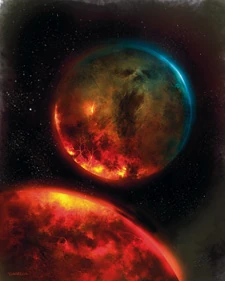 The Star Spawn Seer is the leader of a cult that worships the Elder Evils, usually the only one who realizes the sheer extent of the cosmic horror that the cult is venerating. The Seer usually arrives as something different, usually a disembodied thing that arrives with the comet, and will take control of the mortal body and spirit of whatever silly cultist or warlock that's trying to contact it, transforming the entity into a Star Spawn Seer. The Seer will develop a lot of tumour-laden skin with strange whorls, and they go around holding their strange staves. Seers will attempt to tap into the energy sources of the material plane and master the rites that will enable it to extend a bridge between the Material Plane and the madness of their Elder Evil masters.
The Star Spawn Seer is the leader of a cult that worships the Elder Evils, usually the only one who realizes the sheer extent of the cosmic horror that the cult is venerating. The Seer usually arrives as something different, usually a disembodied thing that arrives with the comet, and will take control of the mortal body and spirit of whatever silly cultist or warlock that's trying to contact it, transforming the entity into a Star Spawn Seer. The Seer will develop a lot of tumour-laden skin with strange whorls, and they go around holding their strange staves. Seers will attempt to tap into the energy sources of the material plane and master the rites that will enable it to extend a bridge between the Material Plane and the madness of their Elder Evil masters.
Sadly, the visuals of the Foulspawn and the description of these lesser Star Spawn aren't the most interesting, but I do like the flavour behind them, and Tome of Foes, while clearly focusing on more classical D&D stuff like the fiends and the drow, do give a decent amount of page-time talking about the Elder Evil blessings, potential encounters with cults of these Elder creatures, including some that Elder Evils that are canon to D&D lore like Borem of the Lake of the Boiling Mud; Atropus, the World Born Dead; Bolothamogg
Who Watches from Beyond the Stars; or Tharizdun, the Chained God. And, of course, you could use the Elder Evils depending on your setting -- beings that are beyond what mortals consider reality; or beings that predate the gods; or simply creatures of the Far relam, et cetera. These sort of Lovecraftian feel tend to not what everyone wants in their D&D, but in little doses, I do love it when the odd monster or two that have a Lovecraftian vibe manages to sneak in, even if these (Larva Mage aside) aren't like, super-duper weird.
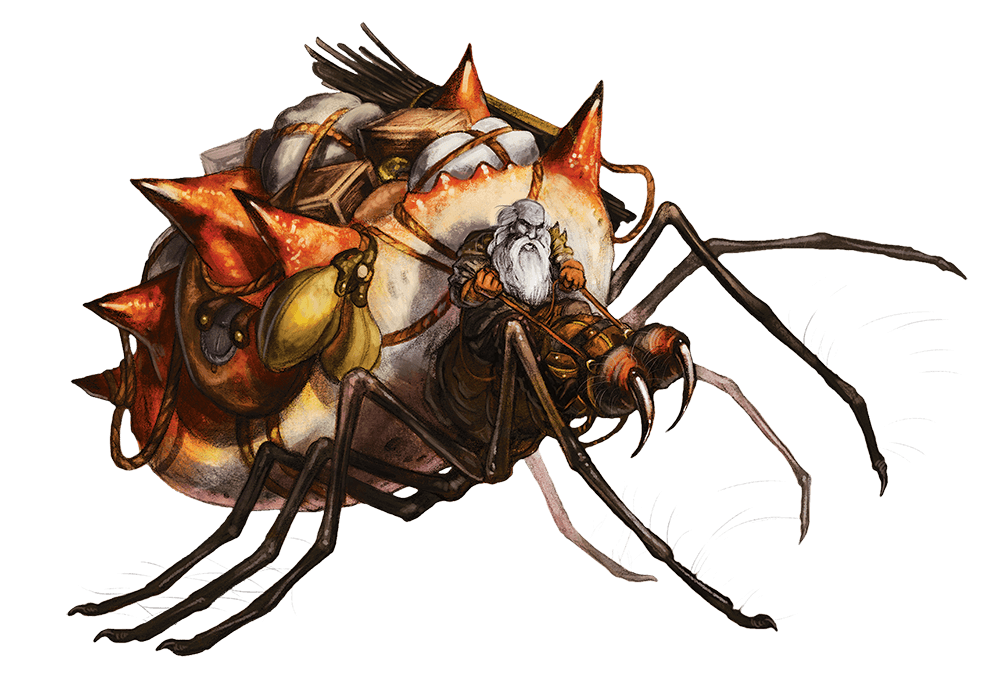

Steeder - 5.5E/5E: Large Monstrosity; Unaligned; CR 1 (Female)
- 5.5E/5E: Medium Monstrosity; Unaligned; CR 1/4 (Male)
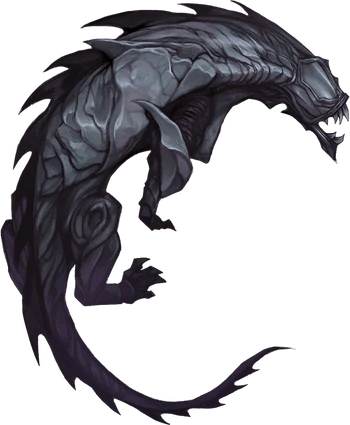
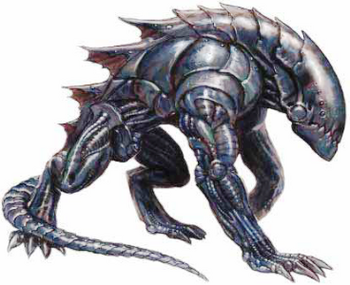
Steel Predator - 5.5E/5E: Large Construct; Lawful Evil; CR 16

Stone-Cursed - 5.5E/5E: Medium Construct; Lawful Evil; CR 1
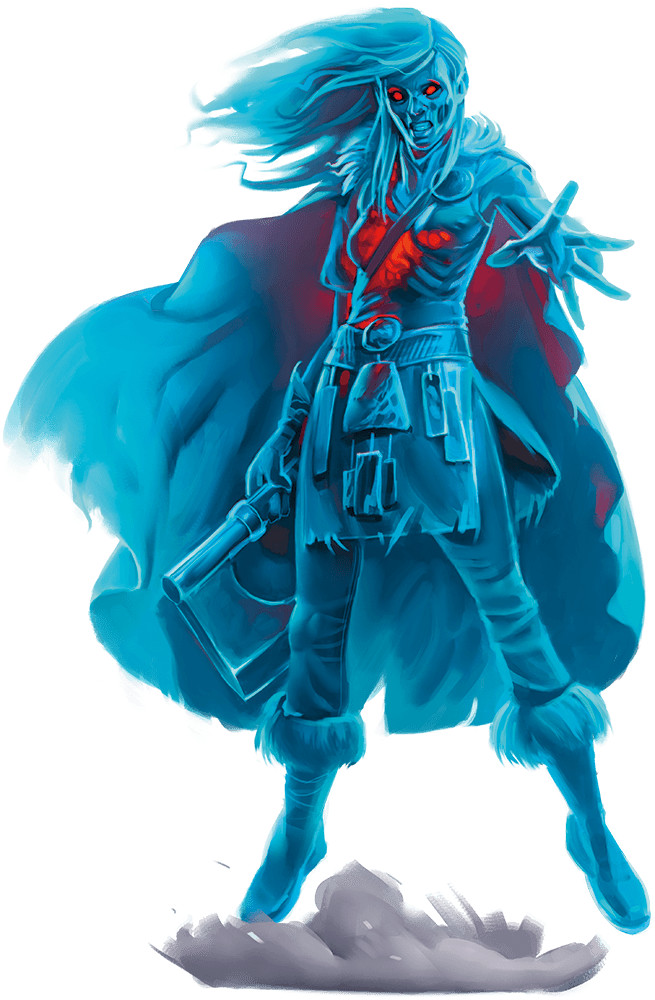
Sword Wraith - 5.5E/5E: Medium Undead; Lawful Evil; CR 8 (Commander), 3 (Warrior)
Tortle
- 5.5E/5E: Medium Humanoid; Lawful Good; CR 1/4 (Tortle), 2 (Druid)
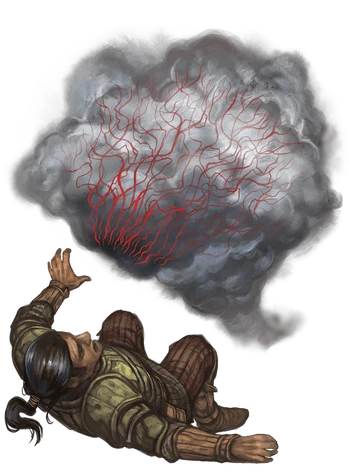
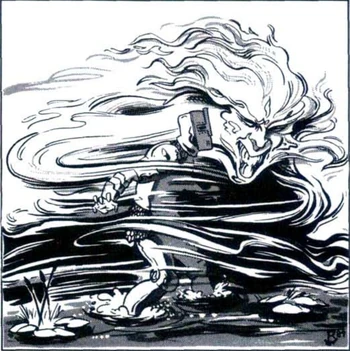
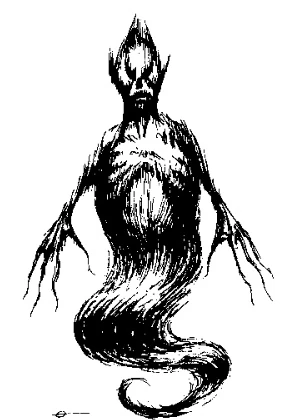
Vampiric Mist - 5.5E/5E: Medium Undead; Chaotic Evil; CR 3
A pretty neat monster to end our coverage on, yeah?
The 5E stats for these creatures. The stats for the Tortle enemy are reprinted here.
- Oblex Spawn: Tiny ooze; lawful evil; CR 1/4
- Adult Oblex: Medium ooze; lawful evil; CR 5
- Elder Oblex: Huge ooze; lawful evil; CR 10
- Retriever: Large construct; lawful evil; CR 14
- Frost Salamander: Huge elemental; unaligned; CR 9
- Gloom Weaver: Medium humanoid - elf; neutral; CR 9
- Shadow Dancer: Medium humanoid - elf; neutral; CR 7
- Soul Monger: Medium humanoid - elf; neutral; CR 11
- Skulk: Medium humanoid; chaotic neutral; CR 1/2
- Skull Lord: Medium undead; lawful evil; CR 15
- The Angry: Medium monstrosity; neutral evil; CR 13
- The Hungry: Medium monstrosity; neutral evil; CR 11
- The Lonely: Medium monstrosity; neutral evil; CR 9
- The Lost: Medium monstrosity; neutral evil; CR 7
- The Wretched: Medium monstrosity; neutral evil; CR 1/4
- Star Spawn Grue: Small aberration; neutral evil; CR 1/4
- Star Spawn Hulk: Large aberration; chaotic evil; CR 10
- Star Spawn Larva Mage: Medium aberration; chaotic evil; CR 16
- Star Spawn Mangler: Medium aberration; chaotic evil; CR 5
- Star Spawn Seer: Medium aberration; neutral evil; CR 13
- Female Steeder: Large monstrosity; unaligned; CR 1
- Male Steeder: Medium monstrosity; unaligned; CR 1/4
- Steel Predator: Large construct; lawful evil; CR 16
- Stone Cursed: Medium construct; lawful evil; CR 1
- Sword Wraith Commander: Medium undead; lawful evil; CR 8
- Sword Wraith Warrior: Medium undead; lawful evil; CR 3
- Tortle: Medium humanoid - tortle; lawful good; CR 1/4
- Tortle Druid: Medium humanoid - tortle; lawful neutral; CR 2
- Vampiric Mist: Medium undead; chaotic evil; CR 3























 The Star Spawn Seer is the leader of a cult that worships the Elder Evils, usually the only one who realizes the sheer extent of the cosmic horror that the cult is venerating. The Seer usually arrives as something different, usually a disembodied thing that arrives with the comet, and will take control of the mortal body and spirit of whatever silly cultist or warlock that's trying to contact it, transforming the entity into a Star Spawn Seer. The Seer will develop a lot of tumour-laden skin with strange whorls, and they go around holding their strange staves. Seers will attempt to tap into the energy sources of the material plane and master the rites that will enable it to extend a bridge between the Material Plane and the madness of their Elder Evil masters.
The Star Spawn Seer is the leader of a cult that worships the Elder Evils, usually the only one who realizes the sheer extent of the cosmic horror that the cult is venerating. The Seer usually arrives as something different, usually a disembodied thing that arrives with the comet, and will take control of the mortal body and spirit of whatever silly cultist or warlock that's trying to contact it, transforming the entity into a Star Spawn Seer. The Seer will develop a lot of tumour-laden skin with strange whorls, and they go around holding their strange staves. Seers will attempt to tap into the energy sources of the material plane and master the rites that will enable it to extend a bridge between the Material Plane and the madness of their Elder Evil masters. 








No comments:
Post a Comment